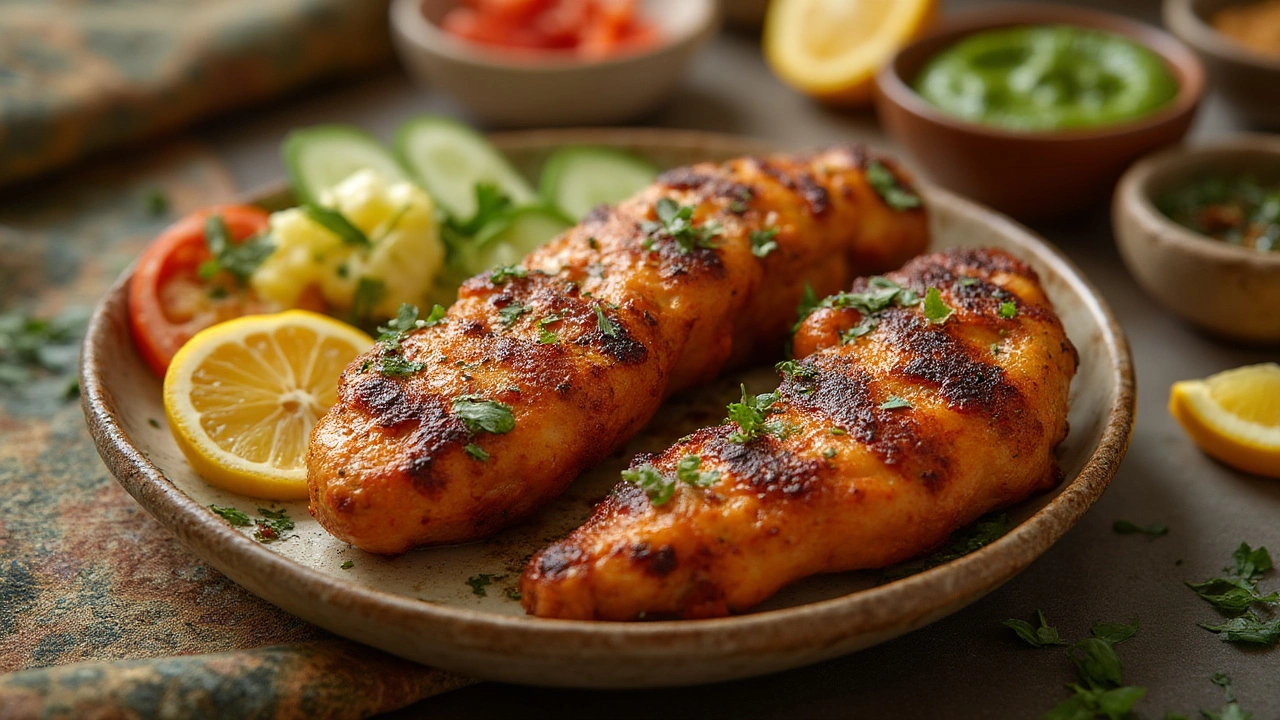18 Jul 2025
- 0 Comments
Ask anyone in my house about Friday night, and they’ll probably mention the aroma of smoked spices drifting from our little kitchen. Tandoori chicken is irresistible—the crackling skin, the rich color, the way those spices wake up your senses. But if you or someone you love manages diabetes, you’re probably asking yourself: is this mouthwatering classic safe to eat? With so much confusing info online, figuring out what actually lands on your plate can feel overwhelming, especially when health is at stake. Wait—could the answer really be yes?
What Makes Tandoori Chicken Different?
Tandoori chicken stands apart from most fried, greasy chicken dishes you’ll find at food stalls or quick service joints for one big reason: how it’s cooked. True tandoori is marinated in yogurt, spices, a squeeze of lemon, and then roasted in a blazing-hot clay oven—the tandoor. There’s no heavy batter. No deep fryer. Just simple, bold flavor without the oil slick, which already sets it up as a healthier alternative for just about anyone keeping an eye on carbs or fats.
You’d be surprised at how many restaurant menu items add sugar or colored syrups to their marinades, trying to mimic that trademark orange-red look. But authentic homemade tandoori chicken? You don’t need food coloring or extra sweeteners. The classic mix—think cumin, coriander, paprika, garam masala, and turmeric—adds plenty of flavor. And if you’re following a typical recipe at home, carbs stay low since it skips breading entirely.
Nutritionally, here’s what 100 grams of tandoori chicken usually provides (without skin, made in a traditional style):
| Nutrient | Amount |
|---|---|
| Calories | 160-190 kcal |
| Protein | 24 g |
| Total Fat | 7 g |
| Carbohydrates | 3-5 g |
| Fiber | 0.5 g |
| Sugar | 1.5 g |
Spin that around in your head for a second—especially the carb content vs. classic battered fried chicken (clocking in at around 12-16 g carbs per 100g). You’re already saving quite a bit on sugar spikes.
Why keep talking about carbs? When you have diabetes, it’s all about managing blood sugar. The fewer quick carbs, the easier it is for your body to stay balanced. Lean meats—especially cooked in a way that ditches deep frying—help a lot! If I’m making tandoori chicken at home for Ivy and Oliver, I leave out honey or sugar in the marinade and just up the lemon juice or ginger.
But before you search for your old tandoor (or oven), a quick word: not all restaurant tandoori chicken is made the same. Some places sneak in refined flour, palm oils, or sweeteners to cut costs or alter texture. When you can, ask what goes in the marinade or, better yet, make it yourself. That way, you know what you’re eating.

Tandoori Chicken and Diabetes: The Science
Time for the serious bit—what does research actually say about chicken, spices, and diabetes? First, let’s tackle the protein question. Chicken breast—especially if you skip the skin—delivers protein without the saturated fat overload you get from red meats. This is brilliant news for people with diabetes, since both weight management and keeping cholesterol low are crucial to long-term health.
Proteins like chicken don’t really spike blood glucose. In fact, eating adequate lean protein at meals can slow down how fast your body digests any carbs in the meal, leading to steadier blood sugar afterwards. That’s helpful for preventing those rollercoaster highs and nasty energy slumps.
The real magic of tandoori chicken, though, may be the spices. Studies on turmeric (which gives tandoori its sunset-yellow base) show curcumin can support better insulin sensitivity—so your body reacts more smoothly to sugar. Fenugreek, coriander, ginger, garlic? Also linked to lowering inflammation and keeping blood sugar steadier over time. Black pepper helps your body absorb more of the good stuff from turmeric, so don’t skimp!
Another bonus: low-carb diets (not zero carb—just lower) tend to work well at keeping A1C and fasting blood glucose in check. If you’re pairing tandoori chicken with high-fiber salads, roasted veggies, or a spoon of unsweetened yogurt instead of heaps of rice or naan, you’ve really nailed that balance. Every tiny food swap counts.
That’s not to say it’s a free-for-all—too much chicken (especially dark meat with skin) means more fat, and sauces can add sneaky calories. Balance is key. If your meal is 40% protein, 40% non-starchy veg, and 20% whole grains (like brown rice or roti), you’re winning. I love tossing cucumber, tomato, and onion with cumin and lemon to round out the meal without shooting up carbs.
And let’s get back to that famous clay oven. Did you know tandoor cooking actually helps cut fat? As the meat roasts, extra fat drips away. No soggy breading holding on to oil. People with diabetes are at higher risk for heart issues, so recipes that lower saturated fats are always smart picks.
One often-asked question: is the red color a problem? Not if you’re using paprika, chili powder, or dried Kashmiri chilis. What you do need to watch for: some restaurants use artificial dyes (like Red 40) just for looks. Skip those when you can.
For comparison, here’s how tandoori chicken stacks up against other popular chicken options per 100g, just for fun:
| Dish | Calories | Carbs (g) | Fat (g) |
|---|---|---|---|
| Tandoori Chicken | 160-190 | 3-5 | 7 |
| Butter Chicken | 210-260 | 9-13 | 14 |
| Fried Chicken (Batter) | 230-280 | 12-16 | 15 |
| Boiled Chicken | 150-170 | 0-1 | 3 |
See what a difference that makes?

Smart Ways to Enjoy Tandoori Chicken on a Diabetes-Friendly Diet
Eating well with diabetes is never about deprivation—it’s all about making swaps and being savvy. Tandoori chicken can absolutely earn a spot on your menu, but how you put the meal together makes all the difference. Here’s how you can enjoy every bite while staying on track.
- Marinate smart: Ditch any sugar, honey, or store-bought packets with mysterious ‘flavor enhancers’. Go for homemade, using lemon, yogurt, chili, ginger, and fresh herbs. Greek yogurt thickens better and adds protein.
- Opt for skinless chicken: Less saturated fat and cholesterol, which is better for heart health—something really important if you’re managing diabetes.
- Pair it right: Think crunchy salads, roasted cauliflower, or sauteed greens. Steamed broccoli and cucumber raita work wonders and keep your carb load gentle. My Ivy loves the nutty crunch of roasted chickpeas as a side, and honestly, it’s yum with the chicken juices.
- Control portions: One or two pieces of tandoori chicken are usually enough for a meal. If you’re eating out, share a plate or box up leftovers. Most restaurants serve huge portions, so don’t feel like you have to finish it all in one go.
- Balance your plate: If you add bread or rice, make it brown rice or whole-wheat roti, but keep portions to about the size of your palm. Stack your plate with salad or non-starchy veg instead.
- Check for hidden sugars and sodium: Many commercial tandoori spice pastes are loaded with extra salt and sometimes sugar. Read labels, or better yet—blend your own masala at home. A mini spice grinder is a life-changer (Oliver swears by ours, and he can barely boil water otherwise).
- Practice mindful eating: Chew slowly, savor the flavors, and notice how you feel. This might sound basic, but sometimes you realize you feel satisfied even with less!
- Plan ahead: Got leftovers? Tandoori chicken tastes amazing cold on green salads or in a lettuce wrap for lunch the next day. Less take-out temptation, more control over what you eat.
Here are a few interesting facts you can throw around at the family dinner table:
- Tandoori chicken first became popular in India in the 1920s, and its traditional marinade was always yogurt-based—no sugars or flours, just plain good bacteria and spices.
- Many antioxidant spices in tandoori chicken, like cumin and coriander, are being studied for their role in fighting inflammation and even lowering blood pressure, which is great news for those with diabetes risks.
- A 2023 study in the Journal of Nutrition Research showed that adding turmeric and black pepper to meals over 12 weeks improved fasting blood sugar in people with pre-diabetes.
- Traditional tandoor ovens reach temps of up to 900°F, cooking chicken super-fast and keeping it juicy without extra oil. Home ovens won’t get this hot but broiling on a rack creates a similar effect.
If taste is your top priority, add a sprinkle of chaat masala or a few pomegranate seeds at serving—extra tang, extra antioxidants, and zero added carb stress. When I make tandoori chicken at home, Ivy always steals the first crispy piece (and licks her fingers), and I love that we’re sharing food that’s flavorful, safe, and special, regardless of dietary needs.
So, can diabetics eat tandoori chicken? With smart choices and a little know-how, diabetics and tandoori chicken go hand in hand—no need to miss out on this Indian favorite.
